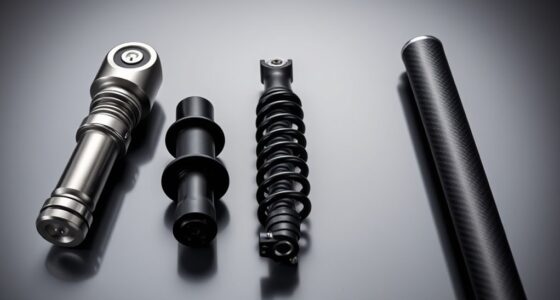When choosing between carbon and aluminum frames, consider your priorities: carbon offers lightweight, stiff, and comfortable rides ideal for racing and long distances, but it can be more vulnerable to impact damage and is pricier to repair. Aluminum frames are heavier but more durable, easier to maintain, and often less costly, making them suitable for everyday riding. To understand which material suits you best and why, keep exploring this detailed comparison.
Key Takeaways
- Carbon frames offer superior weight savings, stiffness, and design flexibility, ideal for racing and performance-oriented cycling.
- Aluminum frames are more durable, easier to repair, and typically more cost-effective, suitable for training and everyday use.
- Carbon’s vulnerability to impact damage and complex repairs may lead to higher maintenance costs over time.
- Aluminum’s resistance to corrosion and material fatigue enhances longevity in challenging environments.
- The choice depends on balancing initial investment, durability, ride comfort, and environmental considerations.
The Evolution of Bike Frame Materials

The evolution of bike frame materials has been driven by the constant pursuit of lighter, stronger, and more durable options. Over time, manufacturers have refined frame geometry to optimize performance, comfort, and handling. As new materials like carbon fiber and aluminum emerged, brands built reputations for innovation and quality, influencing rider trust. Early aluminum frames offered affordability and decent strength, but lacked the finesse of modern designs. Carbon fiber, with its customizable stiffness and weight savings, transformed the industry, prompting brands to innovate further. Your choice now hinges on understanding how these materials affect performance and how brand reputation assures quality. This ongoing evolution continues to shape what you expect from your bike, balancing performance, durability, and reputation. Recognizing the importance of creative practice can inspire manufacturers to develop innovative materials and designs that meet evolving rider needs, including considerations like frame material properties and their impact on ride quality. Additionally, understanding state tax implications can be crucial for consumers planning long-term investments in their cycling gear, especially when purchasing high-end frames.
Weight and Stiffness: How They Impact Performance

Weight and stiffness are critical factors that directly influence your bike’s performance. A lightweight frame reduces fatigue and improves acceleration, while proper weight distribution enhances handling. Frame stiffness determines how efficiently power transfers from your pedaling to the road, affecting responsiveness and comfort. Carbon frames tend to be stiffer and lighter, optimizing sprinting and climbing. Aluminum frames are usually heavier but offer decent stiffness, providing a reliable ride. Consider this table:
| Frame Material | Weight (per frame) | Stiffness | Impact on Performance | Notes |
|---|---|---|---|---|
| Carbon | Light | High | Fast acceleration, responsive | Ideal for racing |
| Aluminum | Moderate | Moderate | Good handling, durable | Suitable for training |
| Carbon | Light | High | Improved power transfer | Better for competitive riding |
| Aluminum | Slightly heavier | Moderate | Stable handling | Budget-friendly option |
| Both | Varies | Varies | Depends on design | Choose based on riding style |
Understanding frame stiffness and weight distribution helps you optimize performance. Material properties play a significant role in selecting the right frame for your riding style. Additionally, choosing the appropriate installation and maintenance practices can ensure your bike maintains optimal performance over time. Regularly assessing frame integrity can prevent potential issues and prolong your bike’s lifespan. Incorporating testing methods can also help evaluate how different frames perform under various conditions. Moreover, considering personal riding preferences can guide you toward a frame that best suits your specific needs and comfort.
Durability and Longevity: Which Material Lasts Longer?
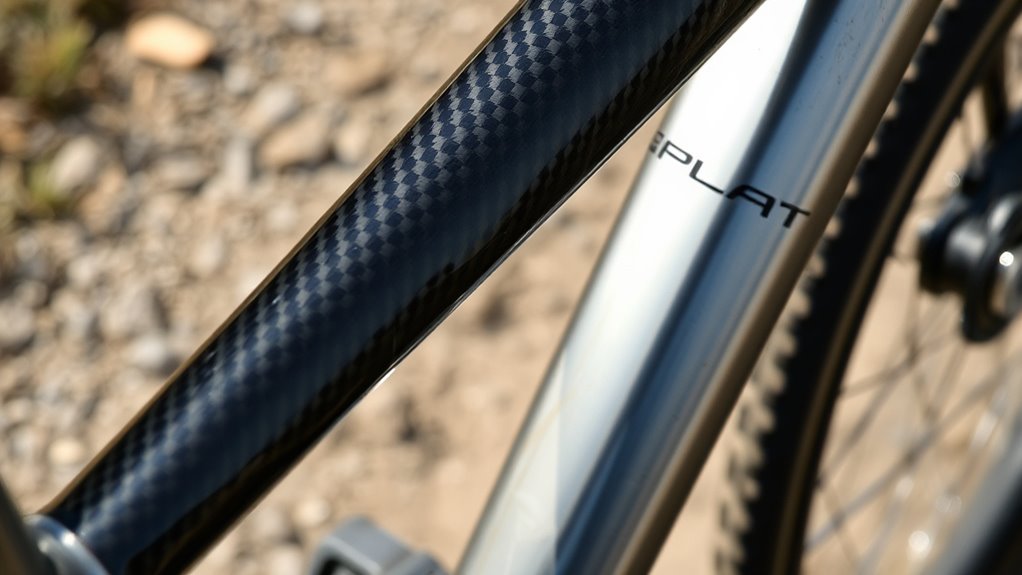
When considering durability and longevity, understanding how carbon and aluminum respond to wear and environmental factors is essential. Aluminum frames are prone to frame corrosion over time, especially in humid or salty environments, which can weaken the structure. They also experience material fatigue after repeated stress, potentially leading to cracks. Additionally, aluminum’s susceptibility to corrosion can be mitigated with proper protective coatings and maintenance. The process of material fatigue involves micro-damage accumulation that gradually reduces structural integrity. Furthermore, recyclability of materials plays a role in their environmental impact and sustainability considerations, influencing long-term ecological footprints. The production processes for each material also significantly impact their overall environmental footprint, with carbon fiber manufacturing typically requiring more energy. Carbon frames, on the other hand, resist corrosion but can be more susceptible to impact damage and delamination, which affects their lifespan. Proper maintenance extends the life of both materials, but aluminum generally withstands environmental challenges better. Moreover, the environmental impact of each material, including their production and disposal, can influence long-term sustainability considerations.
Comfort and Vibration Absorption
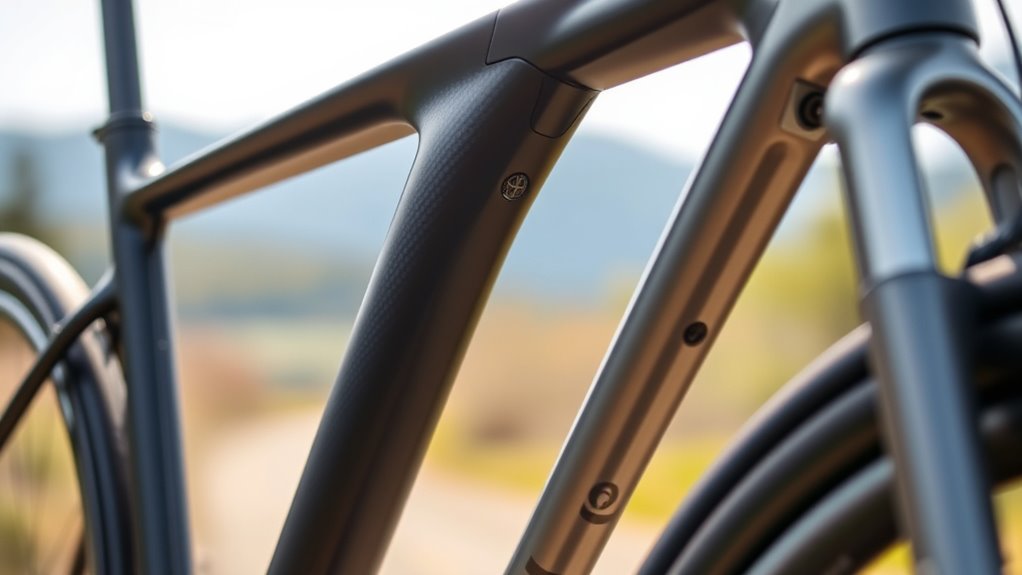
When you ride, the way your frame absorbs shocks directly affects your comfort. Carbon frames are known for their superior vibration damping, providing a smoother ride, while aluminum frames often transmit more road feel. Understanding these differences helps you choose a bike that feels comfortable and responsive on longer rides. Additionally, the choice of material can influence how well the frame manages risk management related to material fatigue over time.
Shock Absorption Capabilities
Carbon frames generally offer superior shock absorption compared to aluminum, resulting in a smoother ride. This is because carbon’s material flexibility allows it to absorb vibrations more effectively, reducing strain on your body. Unlike aluminum, which is stiffer, carbon’s ability to flex slightly helps dampen impacts. When choosing a frame, consider:
- Enhanced vibration dampening due to material flexibility
- Lower frame stiffness translating to better shock absorption
- Carbon’s capacity to bend slightly under stress, smoothing out rough surfaces
- Aluminum’s rigidity, which transfers more shock to you
- The influence of frame design and tube shaping on shock absorption
Understanding these factors helps you identify which frame type aligns with your comfort needs, especially on uneven terrain or long rides.
Ride Comfort and Feel
Because of its flexible nature, a carbon frame typically delivers a more comfortable ride by effectively absorbing vibrations and reducing the jarring feel of rough surfaces. Its excellent vibration damping minimizes fatigue and enhances long-distance comfort. Carbon’s lower frame stiffness allows it to flex slightly under load, smoothing out minor bumps. In contrast, aluminum frames tend to be stiffer, transmitting more road buzz and vibrations to you. This increased stiffness can make rides feel sharper but less forgiving on rough terrain. Overall, if you prioritize ride comfort and a smoother feel, a carbon frame’s superior vibration damping and flexible design make it the better choice. It creates a more natural, cushioned experience that keeps you comfortable mile after mile. Additionally, understanding AI safety measures is crucial as technology advances, ensuring rider safety and system reliability.
Cost Considerations and Value for Money
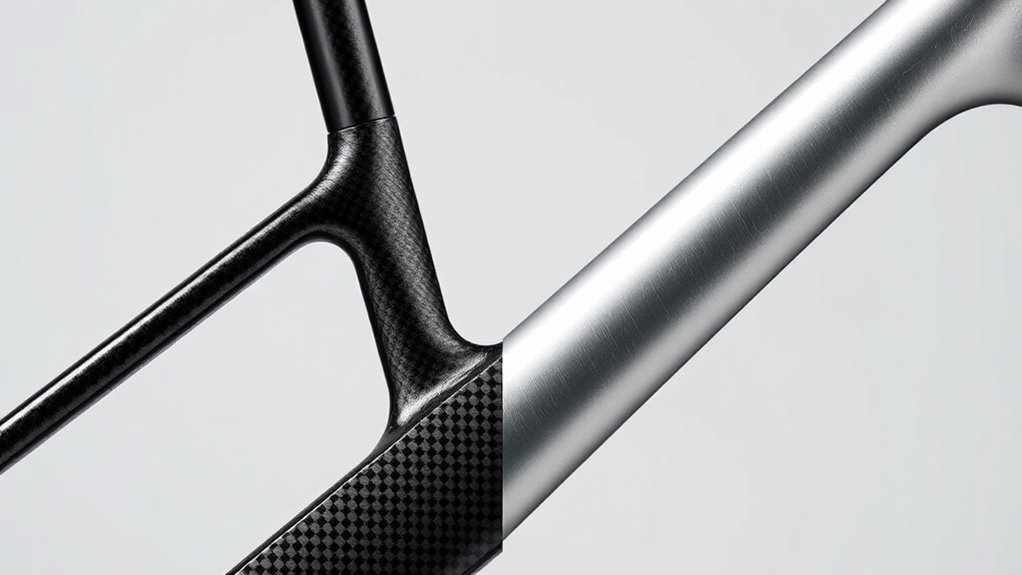
While carbon frames often come with a higher upfront cost, they can offer better long-term value through reduced weight and increased durability. The key is understanding the price differences and how they impact your overall investment. Carbon bikes tend to have a higher resale value, making them more attractive if you decide to upgrade later. Consider these factors:
- Initial purchase price and budget fit
- Durability and maintenance costs over time
- Resale value retention
- Long-term performance benefits
- Overall cost-to-benefit ratio
Although aluminum frames are generally cheaper initially, their lower resale value and potential for more frequent repairs may add up over time. Additionally, the weight of the frame can significantly influence ride quality and handling, especially in off-road conditions. Weighing these aspects helps you determine which frame offers the best value for your riding style and budget.
Aesthetic Flexibility and Customization Options

When it comes to aesthetic flexibility and customization options, you’ll find that carbon frames generally offer a broader range of design possibilities. They enable you to choose from custom color options and intricate patterns, enhancing your bike’s visual appeal. Carbon’s design versatility allows for sleek, aerodynamic shapes and unique finishes that are difficult to achieve with aluminum. This means you can personalize your bike to reflect your style more vividly. To illustrate, here’s a quick comparison:
| Feature | Carbon Frames | Aluminum Frames |
|---|---|---|
| Custom Color Options | Wide, vibrant choices | Limited, standard colors |
| Design Versatility | High, complex shapes | Moderate, simpler designs |
| Finish Options | Matte, gloss, textured | Usually paint or anodized |
| Pattern Capability | Intricate, layered designs | Basic finishes |
| Overall Customization Flexibility | Superior | More basic |
Additionally, the material properties of carbon allow for more innovative and complex structural designs that can be tailored to specific aesthetic preferences and performance needs.
Environmental Impact and Sustainability

You should consider how manufacturing emissions differ between carbon and aluminum frames, as this impacts their overall environmental footprint. Recycling and the lifespan of each material also play a role in sustainability, influencing how often they need replacement. Additionally, think about the resource extraction process, since it affects ecosystems and long-term environmental health. Resource extraction processes can have significant ecological impacts, making sustainable sourcing vital for minimizing environmental harm. Automation in business advancements can also contribute to more sustainable manufacturing practices by optimizing resource use and reducing waste. Moreover, innovations in trailer music composition techniques can lead to more efficient production workflows that minimize environmental impact. Vetted – Two Green Leaves, indicating a focus on eco-friendly and sustainable choices, supports the importance of integrating community resilience strategies into manufacturing processes to further enhance sustainability by fostering adaptive and eco-friendly practices.
Manufacturing Emissions Comparison
Manufacturing emissions for carbon fiber frames generally tend to be higher than those for aluminum frames due to the energy-intensive processes involved in producing carbon fibers. The environmental impact starts with material sourcing, which requires significant energy to extract and process raw materials. Carbon fiber production involves steps like polymerization and carbonization, consuming large amounts of energy. In contrast, aluminum frames are made through smelting, which also uses substantial energy but is more established.
- Carbon fiber manufacturing demands high energy for precise curing and processing
- Material sourcing for aluminum relies on bauxite mining, impacting ecosystems
- Carbon fiber’s production involves multiple energy-intensive steps
- Aluminum’s smelting process releases more greenhouse gases
- Both materials have distinct environmental footprints during manufacturing, affecting sustainability choices
Recyclability and Lifecycle
Recyclability and lifecycle considerations reveal important differences between carbon fiber and aluminum frames. Carbon fiber faces recyclability challenges because breaking down the composite material is complex and energy-intensive, often limiting its reuse. In contrast, aluminum is highly recyclable; it can be melted down and reformed repeatedly without significant loss of quality. A thorough lifecycle assessment shows aluminum frames typically have a lower environmental footprint over their lifespan, thanks to easier recycling and longer durability. Carbon frames, while lighter and potentially more durable in use, pose greater environmental concerns due to their end-of-life disposal difficulties. Your choice impacts sustainability, making it essential to consider not just performance but also how each material fits into a circular economy and overall environmental impact.
Resource Extraction Impact
The environmental impact of resource extraction for carbon fiber and aluminum frames varies markedly, influencing their sustainability profiles. Mining practices and material sourcing play a pivotal role in this process. Aluminum production relies heavily on bauxite mining, which can cause deforestation and habitat loss. It also consumes significant energy, contributing to greenhouse gas emissions. Carbon fiber manufacturing involves extracting precursor materials like polyacrylonitrile, which requires intensive chemical processing. This process often results in chemical waste and pollution. Additionally, sourcing raw materials sustainably remains a challenge for both frames. Consider these points:
- Aluminum mining’s habitat disruption and energy demands
- Chemical waste from carbon fiber precursor production
- Carbon footprint tied to extraction and processing
- Ethical concerns over mining practices
- Efforts to improve sustainable sourcing methods
These factors directly impact each frame’s overall environmental footprint.
Maintenance and Repair Needs

When it comes to maintenance and repairs, carbon frames generally require more careful handling and specialized attention compared to aluminum. Carbon’s frame flexibility makes it sensitive to impacts, so any accidental knocks or crashes can cause cracks or delamination, which are often difficult to detect. Repairing carbon frames typically involves professional work, which can be costly and time-consuming. In contrast, aluminum frames are more durable and easier to fix; minor dents or cracks can often be repaired with simpler techniques. Additionally, aluminum offers excellent corrosion resistance, making it less prone to rust over time. This means less worry about environmental damage and lower maintenance costs in the long run. Overall, aluminum frames demand less specialized care, while carbon frames need more vigilant maintenance to stay in top condition.
Making the Final Choice: Factors to Consider
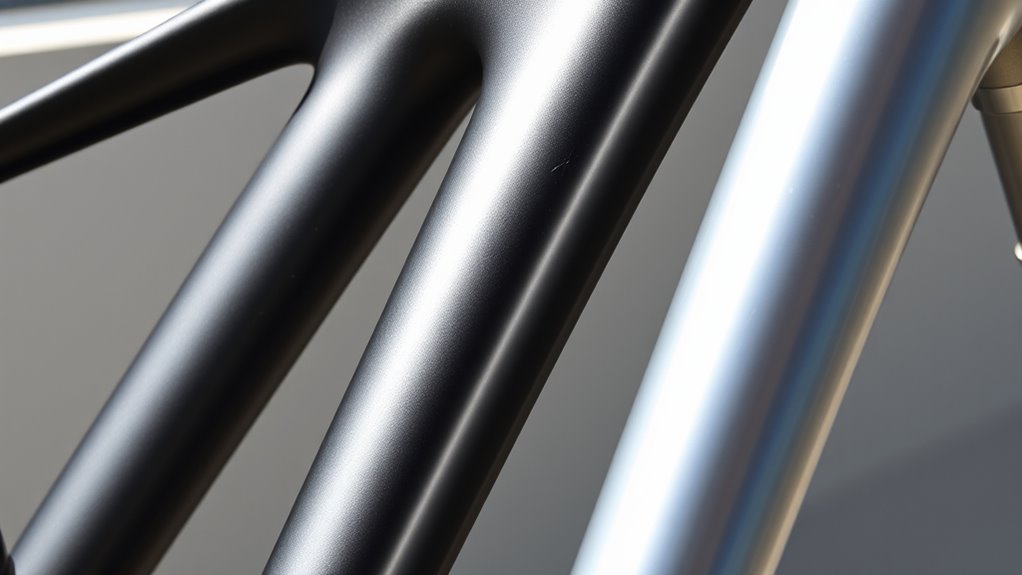
Choosing between a carbon and an aluminum frame depends on several key factors that align with your riding style, budget, and maintenance preferences. Consider how frame aesthetics influence your choice—carbon often offers sleeker designs, while aluminum can be more utilitarian. Brand reputation plays a role, as trusted brands guarantee quality and support. Think about weight differences, with carbon typically being lighter. Durability varies: aluminum resists impacts better, but carbon can be more sensitive to damage. Price points are vital; aluminum tends to be more affordable upfront. Ultimately, your long-term maintenance needs and repair options might sway your decision.
Choosing a carbon or aluminum bike depends on your riding style, budget, and durability needs.
- Frame aesthetics and design appeal
- Brand reputation and reliability
- Weight and riding efficiency
- Durability and impact resistance
- Budget and value for money
Frequently Asked Questions
How Do Frame Materials Affect Overall Riding Experience?
Your riding experience is influenced by frame materials, which affect frame stiffness and comfort. Carbon frames tend to be stiffer, offering immediate power transfer, but can feel harsh on rough surfaces. Aluminum frames are usually less stiff, providing a more forgiving ride. Material cost also plays a role; carbon is pricier but offers lightweight benefits, while aluminum is more affordable and durable. Your choice impacts handling, comfort, and overall ride quality.
Can Frame Material Choice Influence Bike Resale Value?
Your choice of frame material can definitely influence your bike’s resale value. Lighter frames, often made from carbon, tend to appeal to enthusiasts and can fetch higher prices, especially if they’re well-maintained. However, manufacturing costs impact resale—aluminum frames are cheaper to produce, which might lower their resale value. So, if you want better resale potential, consider how frame weight and manufacturing costs affect demand among buyers.
Are There Health Risks Associated With Carbon or Aluminum Frames?
You might wonder if carbon or aluminum frames pose health risks. Generally, these frames are safe, but some people with frame allergy could react to chemicals used in manufacturing. To guarantee chemical safety, choose bikes from reputable brands that follow strict manufacturing standards. If you’re concerned about allergies, test ride or consult a specialist. Rest assured, most riders enjoy their bikes without health issues from the frame materials.
How Do Weather Conditions Impact Frame Material Durability?
Weather conditions markedly impact your bike’s frame durability, especially regarding weather resistance. Extreme rain or humidity can lead to frame corrosion if your bike’s materials aren’t resistant. Aluminum frames tend to resist corrosion better than some other materials, but carbon frames can be affected if not properly protected. Regular maintenance, like cleaning and applying protective coatings, helps prevent damage and extends your frame’s lifespan in various weather conditions.
What Are the Best Frames for Specific Cycling Disciplines?
Imagine you’re choosing a weapon tailored for battle, each frame telling a different story. For mountain biking, opt for a sturdy aluminum frame with excellent durability and reasonable weight, perfect for rough terrains. For road racing, a lightweight carbon frame enhances speed and finesse. Consider aesthetic appeal; some prefer sleek carbon for its modern look, while others like the rugged charm of aluminum. Match your discipline to the frame’s weight and style for ideal performance.
Conclusion
Choosing between carbon and aluminum frames is like picking the right tool for a job—you’ll want the one that best fits your riding style and priorities. Think of it as balancing speed, durability, comfort, and cost on a tightrope. No matter your choice, understanding each material’s strengths helps you make an informed decision. Ultimately, your bike is your adventure partner—select the frame that keeps you riding smoothly down your personal path.





